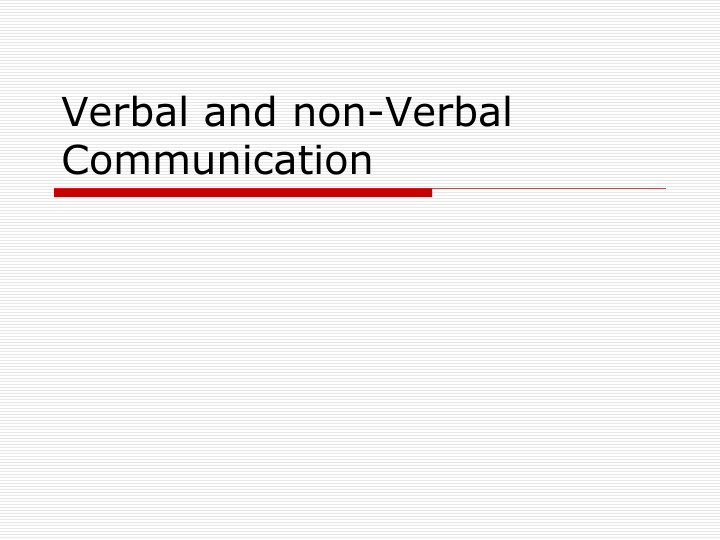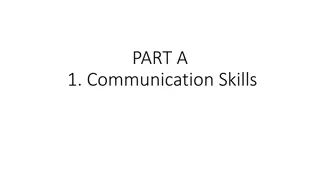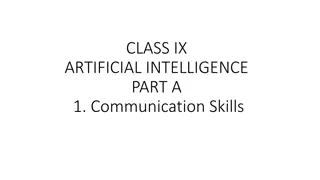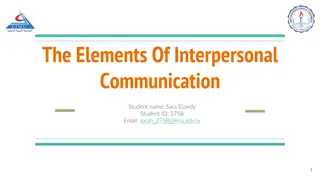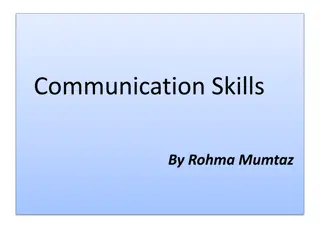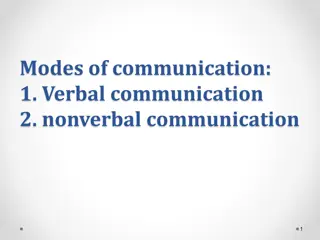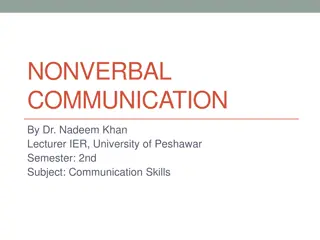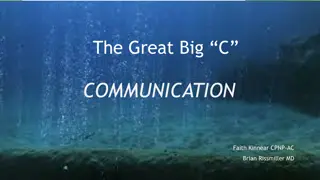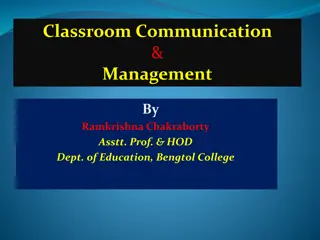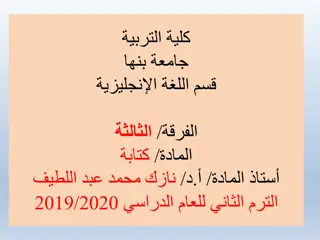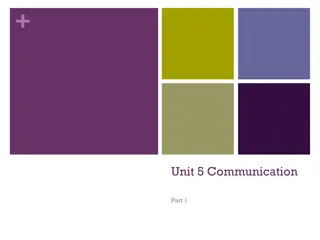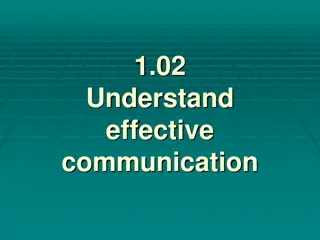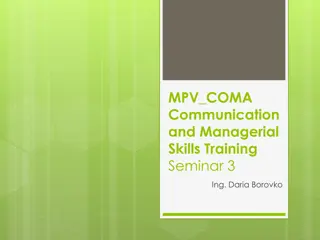Verbal and Non-Verbal Communication
Verbal communication involves both speaking and listening, with listening being equally essential. It can be classified into sympathetic and empathetic listening, each serving different purposes in understanding others' feelings. Sympathetic listening involves sharing emotions, while empathetic listening goes a step further to acknowledge and understand feelings. Effective speaking comprises knowing what to speak and how to speak, emphasizing the importance of communication skills beyond just talking.
Uploaded on Oct 07, 2024 | 0 Views
Download Presentation

Please find below an Image/Link to download the presentation.
The content on the website is provided AS IS for your information and personal use only. It may not be sold, licensed, or shared on other websites without obtaining consent from the author.If you encounter any issues during the download, it is possible that the publisher has removed the file from their server.
You are allowed to download the files provided on this website for personal or commercial use, subject to the condition that they are used lawfully. All files are the property of their respective owners.
The content on the website is provided AS IS for your information and personal use only. It may not be sold, licensed, or shared on other websites without obtaining consent from the author.
E N D
Presentation Transcript
Verbal and non-Verbal Communication
Verbal Communication. We may often think that, having good communication skills is all about the ability to speak well .. Or all about SPEAKING.
We are right But only 50% right. Because . Verbal Communication has another very important part LISTENING . Speaking + Listening = Verbal Communication.
Broadly, LISTENING may be classified into Sympathetic Listening and Empathetic Listening.
Sympathetic LISTENING In sympathetic listening we care about the other person and show this concern in the way we pay close attention and express our sorrow for their ills and happiness at their joys. In other words there is sharing of feelings.
Example for sympathetic listening On your way back from office, you slip and fall and hurt your back. When you reach home your family members Feel for you. They share your hurt feelings and maybe even shed a tear in sympathy.
Empathetic LISTENING When we listen empathetically, we go beyond sympathy to seek a truer understanding of how others are feeling. discrimination and close attention to emotional signals. When we are being truly empathetic, we actually acknowledge what they are feeling. In order to get others to expose these deep parts of themselves to us, we also need to demonstrate our empathy in our demeanor towards them, listening sensitively and in a way that encourages self-disclosure This requires excellent
Example for empathetic listening On your way back from office, you slip and fall and hurt your back. You visit your doctor. Your doctor does not share your feelings. He does not reject or trifle your feelings, but on the contrary, he acknowledges your feelings totally and treats you for your injuries. Here, there is no sharing of feelings, but acknowledgement of feelings.
Speaking consists of two parts 1) What to Speak. and 2) How to Speak.
1) What to Speak. Content development: *The first step is Brainstorming. *The next step is to choose a Presentation Format/ Storage System. *The Final step is the Presentation itself.
Brain Storming Individual Brainstorming is the process of you getting your ideas out on paper. The idea is to put down all of / most of your ideas on paper. This has two advantages. 1.It encourages the unrestricted flow of thoughts. 2. It facilitates the strategic or comparative evaluation of your ideas .ie. Once on paper, you have the opportunity of ranking your ideas in terms of importance and efficacy. You may now put your ideas against one another and choose the best ones.
Putting them all together Now that we know what we are going to speak, we need to put down all our ideas in the most presentable manner. We need a Format as per which we may present these Ideas. We may call it a Presentation/Display Format or a Storage System.
Need for Storage Systems Asked a question, Do we forget due to nervousness or Do we get nervous due to forgetting? Eg. What if you had to recite the alphabet in front of an audience? would you get nervous? Obviously Not! Or
Why do we get Nervous? Nervousness does not cause as much Forgetting as .. Forgetting causes Nervousness. *One of the main causes of Nervousness is Forgetting , or rather, The Fear of Forgetting . *In other words, we would not get nervous if we knew for certain that we would not forget our lines.
So, to prevent forgetting, we need A Good Storage System or A Good Retrieval System . A Good Storage System or Display Format, also makes it easy for our listeners to understand our Ideas easily. Let us check out a few of these Filing Systems.
Storage System 1 IBC Introduction, Body, Conclusion format 1.Introduce the Topic or what you are going to say. 2.In the Body, add a few Supporting ideas to build further. 3.End with appropriate Conclusion.
Storage System 2 WHPI 1.What Begin with the End/Conclusion . 2.How .How do we support the Conclusion.. 3.Prove It . Using examples/Case Studies/Statistics. 4.Conclude with I hope I have been able to ..(use conclusion used in the beginning).
Storage System 3 Time Sequence 1.Start with Reference/Relevance to The Past 2.Continue with Reference/Relevance to The Present 3.Project The Future (With Personal Touch).
Storage System 4 +ve , -ve, personal touch 1.Introduction with +ve (advantages/strengths). 2.Continue with ve (disadvantages/weaknesses). 3.Give your Personal opinion based on how you ve evaluated the +ve and ve.
2) How to Speak. Guidelines Speed Clarity Punctuation Pronunciation Familiarity Fluency Expression
Speed Speed .number of words per minute. While Most Indians speak at 170 to 180 wpm, their foreign counterparts speak at 110 to 120 wpm. Slowing down on rate of speech is the first step towards better speech.
Clarity Clarity if audible & free of distortion. Speech should be loud enough to carry to all the listeners. Voice Clarity can be mastered with regular practice.
Pronunciation Pronunciation . Always remember that English is not "phonetic". That means that we do not always say a word the same way that we spell it. Use a Good Dictionary or work with your Trainer to Correct pronunciation.
Punctuation Punctuation use of various kinds of pauses. Pause spotS lluF ta . Pause sammoC ta . Pause snoloc imeS ta . Pause skram noitcejretnI ta . Pause skram noitseuQ ta .
Familiarity Familiarity with words used. Learning new words Using known words in new contexts Understanding contexts and situations before reading again..
Fluency Fluency Able to express easily. Developing Fluency fo rettam a si ni sretemarap rehto eht lla gnivah ecalp . Fluency elbatrofmoc a taht setacidni sah egaugnal eht htiw ytiliba gnikrow dehsilbatse neeb .
Expression Expression transforming of ideas into words Expression htiw sgnileef tnereffid fo dna hctip ,enot ,sserts drow,sdrow noitcelfni .
Definition of NVC All communication other than that involving words and language This is fine but could include everything from animal communication to films. For our purposes we will use a more restricted definition: Bodily communication, other than words and language
Forms 1. Different categories (or types) of NVC 2. The functions (or uses) of NVC Before we do this, we need to establish some general points about NVC and its relationship to language and culture
Relationship between NVC, Language & Culture When travelling, we do not, on the whole, make the assumption that everyone will understand our first and preferred language Most of us accept we must either learn a new language or rely entirely on verbal signals for communication We assume we will have no difficulty in decoding non-verbal clues We need to be aware of the enormous range and diversity of non-verbal behaviour
NVC, Language & Culture Even in the secure territory of your own familiar culture, care is needed in the interpretation of non-verbal clues Jumping to conclusions about meanings of non-verbal clues can be dangerous
Categorisation of NVC Paralanguage Paralanguage consists of the non-verbal elements that accompany speech. It includes: - The way we speak (also known as prosodic features) - Volume, pitch, intonation, speed of delivery, articulation, rhythm - The sounds we make other than language - Laughter, crying, yawning, sighing, screeching, coughing - Filled pauses such as Mmmm , Ahhh , Ummm - Unfilled pauses
Categorisation of NVC Physical Appearance Clothing, hairstyle, make-up, jewellery, tattoos, piercings, glasses, facial hair, accessories such as bags You only have to think of the huge industries associated with the above examples to recognise the cultural significance of physical appearance
Categorisation of NVC Physical Appearance Many societies had (and some still do have) highly regulated codes of dress, often linked to rank and status It is the body s capacity to communicate aspects of an individual s identity which makes us so aware of our physical appearance
Categorisation of NVC Physical Appearance Self expression in contemporary culture is also limited by requirements to wear uniforms or to observe dress codes Not necessarily restricted to schools and public services Many corporations and organisations expect employees to communicate a corporate rather than an individual identity
Further Categories of NVC - Activity _ Body movement (kinesics) - Closeness (proxemics) - Touching - Eye movement - Smells
Body Movement - Kinesics Gesture, facial expression, posture, head nodding, orientation Emblems gestures with specific cultural meanings attached Illustrators reinforce words of speakers Adapters are unconscious gestures to relieve stress or boredom Posture is heavily laden with value judgements
Closeness - Proxemics Study of how we use space and distance Includes seating arrangements, queuing and territoriality Ideas of personal space , invasion of personal space and comfort zones Use of objects as markers to indicate ownership of space
Touching - Haptics Physical contact such as holding, stroking, shaking hands, guiding Linked to proxemics Touch is very important in our early development Many rules and taboos regulating physical contact
http://buytaert.net/eye Eye Movement Eye movement, length and direction of gaze, changes in pupil size We are hypersensitive to information imparted by eyes Can be argued eyes reveal the truthfulness of what is being said
Smell Smell Humans do not have a particularly well-developed sense of smell compared with other species Perfumes and deodorants send powerful messages, as can the natural body odours we try to suppress A rapidly growing industry has developed around the use of smells
Complex Messages Rare for these non-verbal codes to operate in isolation from one another, or separately from language We create and perceive messages using signs from a range of verbal and non- verbal codes To make this even more complex, these signs and codes to not always pull in the same direction
Communicative Competence A competent communicator will: - Recognise and use different verbal and non- verbal styles as they are suited to different social situations - Recognise the relation between verbal and non-verbal elements in communication - Compensate for possible misinterpretations in communication with others
The Functions of NVC Communicating feelings, emotions and attitudes Replacing and regulating language Other Functions
Communicating Feelings, Emotions and Attitudes NVC has a particularly important role in establishing and maintaining relationships, otherwise known as an affective function We rely more heavily on NVC in this area of personal communication Looks, glances, changes in orientation allow others to know what sort of relationship we want to have We use NVC to establish a mutually acceptable level of intimacy
Replacing & Regulating Language The role of NVC in inflecting the meaning of a sentence can be explored by performing the following sentence in different ways Well, I really enjoyed the party last night.
Replacing & Regulating Language Paralinguistic features, such as pitch, tone and emphasis Throw in other non-verbal cues such as eyebrow lifting or illustrators such as the use of the index and first finger of both hands to indicate inverted commas around a word Number of potential meanings rapidly increases
